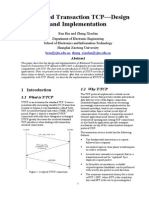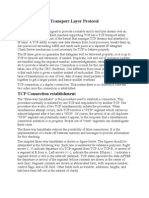Flow Control Using Windowing 1
Uploaded by
Ng Bao WenFlow Control Using Windowing 1
Uploaded by
Ng Bao WenFlow Control Using Windowing
TCP implements flow control by using a window concept that is applied to the
amount of
data that can be outstanding and awaiting acknowledgment at any one point in time.
The
window concept lets the receiving host tell the sender how much data it can receive
right
now, giving the receiving host a way to make the sending host slow down or speed
up. The
receiver can slide the window size up and down—called a sliding window or dynamic
window—
to change how much data the sending host can send.
The sliding window mechanism makes much more sense with an example. The
example,
shown in Figure 1-9, uses the same basic rules as the examples in the previous few
figures.
In this case, none of the TCP segments have errors, and the discussion begins one
TCP segment
earlier than in the previous two figures.
Begin with the first segment, sent by the server to the PC. The Acknowledgment field
should be familiar by now: it tells the PC that the server expects a segment with
Flow Control Using Windowing 1
sequence
number 1000 next. The new field, the window field, is set to 3000. Because the
segment
flows to the PC, this value tells the PC that the PC can send no more than 3000
bytes over
this connection before receiving an acknowledgment. So, as shown on the left, the
PC realizes
it can send only 3000 bytes, and it stops sending, waiting on an acknowledgment,
after
sending three 1000-byte TCP segments.
Continuing the example, the server not only acknowledges receiving the data
(without
any loss), but the server decides to slide the window size a little higher. Note that
second
message flowing right to left in the figure, this time with a window of 4000. Once the
PC
receives this TCP segment, the PC realizes it can send another 4000 bytes (a
slightly larger
window than the previous value).
Note that while the last few figures show examples for the purpose of explaining how
the
mechanisms work, the examples might give you the impression that TCP makes the
hosts
sit there and wait for acknowledgments a lot. TCP does not want to make the
sending host
have to wait to send data. For instance, if an acknowledgment is received before the
window
is exhausted, a new window begins, and the sender continues sending data until the
current window is exhausted. Often times, in a network that has few problems, few
lost segments, and little congestion, the TCP windows stay relatively large with hosts
seldom waiting to send.
Flow Control Using Windowing 2
You might also like
- Visible Learning Feedback by John Hattie Shirley Clarke - Z Lib - Org100% (1)Visible Learning Feedback by John Hattie Shirley Clarke - Z Lib - Org297 pages
- Number So That Jessie Knows Which Application To Give The DataNo ratings yetNumber So That Jessie Knows Which Application To Give The Data4 pages
- CCNA 200-301 Official Cert Guide, Volume 2-21No ratings yetCCNA 200-301 Official Cert Guide, Volume 2-213 pages
- Computer Networks (CS425) : Transport Layer Protocol (Continued)No ratings yetComputer Networks (CS425) : Transport Layer Protocol (Continued)4 pages
- CN_37-38 TCP Message Format and HandshakingNo ratings yetCN_37-38 TCP Message Format and Handshaking20 pages
- Ex No: Date: Simulation of TCP Using NS-2 AimNo ratings yetEx No: Date: Simulation of TCP Using NS-2 Aim11 pages
- Ensuring Your Office 365 Network Connection Isn't Throttled by Your Proxy - On The Wire - Site Home - TechNet BlogsNo ratings yetEnsuring Your Office 365 Network Connection Isn't Throttled by Your Proxy - On The Wire - Site Home - TechNet Blogs5 pages
- CCNA 200-301 Official Cert Guide, Volume 2-20No ratings yetCCNA 200-301 Official Cert Guide, Volume 2-203 pages
- Module 5-6: Manages The Rate of Data Transmission Using The Receiver's Window Size (RWND) To AvoidNo ratings yetModule 5-6: Manages The Rate of Data Transmission Using The Receiver's Window Size (RWND) To Avoid16 pages
- Client Socket Interactions During Slow StartNo ratings yetClient Socket Interactions During Slow Start5 pages
- Enhanced Transaction TCP-Design and Implementation: 1.1 What Is T/TCP 1.2 Why T/TCPNo ratings yetEnhanced Transaction TCP-Design and Implementation: 1.1 What Is T/TCP 1.2 Why T/TCP10 pages
- NS Simulation Implementing Large Window Over TCP SACKNo ratings yetNS Simulation Implementing Large Window Over TCP SACK5 pages
- System Internal Controls Management AccountantsNo ratings yetSystem Internal Controls Management Accountants13 pages
- WXES2106 Network Technology Semester 1 2004/2005: Intermediate TCPNo ratings yetWXES2106 Network Technology Semester 1 2004/2005: Intermediate TCP23 pages
- TCP 3-Way Handshake (SYN, SYN-ACK, ACK) Day 6No ratings yetTCP 3-Way Handshake (SYN, SYN-ACK, ACK) Day 63 pages
- Ex - No:5-C Date: Study of Udp/Tcp PerformanceNo ratings yetEx - No:5-C Date: Study of Udp/Tcp Performance16 pages
- Pia A320 Sop Ed4 Rv1 Effective Jan 2023No ratings yetPia A320 Sop Ed4 Rv1 Effective Jan 2023148 pages
- Especificaciones Tecnicas Bulldozer D51EX-22100% (1)Especificaciones Tecnicas Bulldozer D51EX-2212 pages
- 100% Stator Earth Fault Protection - Relion 670 - ABB - Settings & HighlightsNo ratings yet100% Stator Earth Fault Protection - Relion 670 - ABB - Settings & Highlights21 pages
- Essentials_of_Veterinary_Microbiology_5th_edNo ratings yetEssentials_of_Veterinary_Microbiology_5th_ed3 pages
- Araya v. JPMorgan Chase Bank, N.A., No. 13-7036 (D.C. Cir. Dec. 30, 2014)No ratings yetAraya v. JPMorgan Chase Bank, N.A., No. 13-7036 (D.C. Cir. Dec. 30, 2014)17 pages
- Dapdap Elementary School: Department of Education Region III Division of Mabalacat City100% (1)Dapdap Elementary School: Department of Education Region III Division of Mabalacat City2 pages
- Knyvienė, I. (2014) A New Approach: The Case Study Method in Accounting, University of Applied Sciences, Faculty of Management and EconomicsNo ratings yetKnyvienė, I. (2014) A New Approach: The Case Study Method in Accounting, University of Applied Sciences, Faculty of Management and Economics5 pages
- Government of India Directorate General of Civil Aviation Form CA-80B Application For Design Organisation Approval (DOA) Under CAR 21, Subpart JBNo ratings yetGovernment of India Directorate General of Civil Aviation Form CA-80B Application For Design Organisation Approval (DOA) Under CAR 21, Subpart JB2 pages
- Elastic Approximation For A Solar Parabolic TroughNo ratings yetElastic Approximation For A Solar Parabolic Trough15 pages
- Study The Change of Current Weld On Mechanical Properties and Microstructure of Low Carbon Steel Welded by Electric Arc WeldingNo ratings yetStudy The Change of Current Weld On Mechanical Properties and Microstructure of Low Carbon Steel Welded by Electric Arc Welding8 pages
- DIGITAL - SIGNATURE & Electronic SignaturesNo ratings yetDIGITAL - SIGNATURE & Electronic Signatures6 pages
- Ethics in Accounting A Decision Making Approach 1st Edition Test Bank Klein100% (47)Ethics in Accounting A Decision Making Approach 1st Edition Test Bank Klein9 pages

























































































